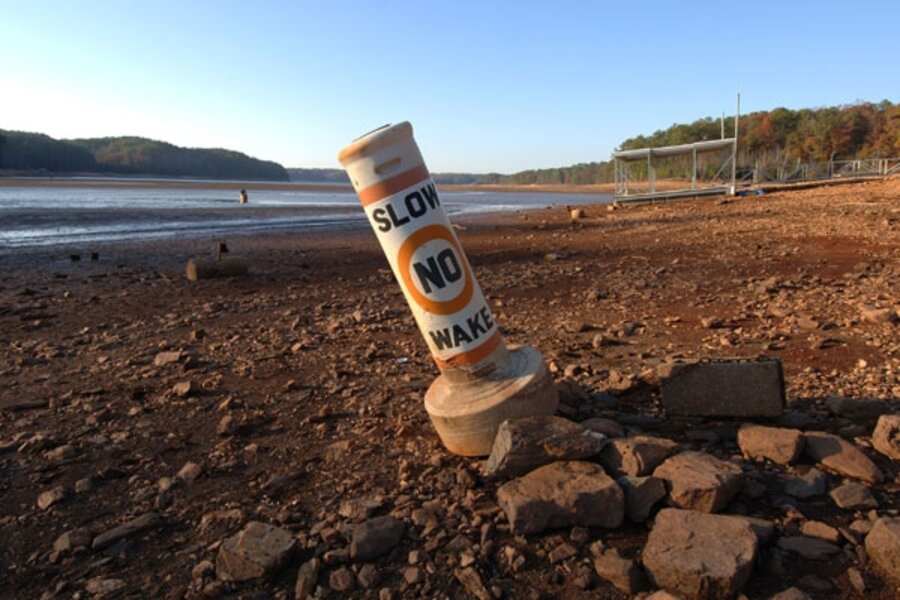Efficiency can reduce water shortages
Loading...
In the winter of 2005-06, a drought began in the Southeastern US. Over the following two years, the region experienced severe water shortages. Lawns went brown, streambeds ran dry, and lakes and reservoirs fell to record lows.
By fall of 2007, Georgia Gov. Sonny Perdue had declared a state of emergency for 85 Georgia counties.
Was the drought, which also seemed to extend laterally to the Southwest, the result of human-induced climate change?
A new Columbia University study concludes that, in this case, climate change wasn't to blame. In fact, historically speaking, the drought wasn't even among the worst of the dry spells that periodically grip the region — the most recent in 1998-2002.
Rather, water shortages in the region — at the height of the drought, Atlanta's main reservoir dropped by over 14 feet — stemmed directly from increased demand on water. And the surging demand was driven by the rapid population growth of recent decades.
An article on Columbia University's Earth Institute website paints the picture by numbers:
In 1990, Georgia, which uses a quarter of the region’s water, had 6.5 million people. By 2007, there were 9.5 million — up almost 50 percent in 17 years. The population is still ascending, driven largely by migration. However, little has been done to increase water storage or reduce consumption. There has been increased sewage discharge near water supplies, and vast tracts of land have been covered with impermeable roofs, roads and parking lots, which drain rainfall away rapidly instead of storing it.
The authors looked at tree rings records stretching back 1,000 years for a sense of how weather has varied in the region in the past. They found that droughts much more severe than the one beginning in 2005 — often lasting more than 25 years — were not without precedent.
One extreme dry spell in the 16th century was linked to the collapse of early Spanish and English colonies —and why Jamestown in Virginia experienced such hardship initially.
The 20th century was relatively wet. But while scientists, including some authors of this study, see evidence of human-driven warming in Southwest's recent drought — temperatures were higher than usual — they fail to find similar evidence of a changing climate in the Southeast's recent water woes. Water shortages there seem to result solely from how it's used.
So, what to do?
The conservation organization American Rivers has a few ideas. In a report titled "Hidden Reservoir: Why Water Efficiency is the Best Solution for the Southeast," it argues that "19th century approaches," such as building more dams and creating more reservoirs, are not adequate to 21st-century challenges. They're up to 8,500 times more expensive than simple "efficiency investments."
The report outlines [PDF] nine such investments. Here are the first four:
Stop leaks. More than 6 billion gallons of water — some 14 percent of total water consumed — are lost through old, leaky pipes.
Price water correctly. The report proposes a flat fee that covers infrastructure costs plus a variable fee that follows the volume of water you use. Pricing water in this way can lessen usage by 15 percent, says the report.
Meter all water users. Condos, apartments, and commercial buildings often get water for a flat fee. Instead, install water meters for every user.
Retrofit all buildings. Water-efficient appliances and fixtures can lessen household water use by 35 percent, or 8.2 billion gallons daily. That would save an amount equivalent to all eight Southeastern states' public water supply, about 20 percent of the country's total water supply.
The report lists several case studies, places that reduced water consumption with improved efficiency:
– Cary, N.C., increased water supply by 11 percent with efficiency measures alone.
– Tampa, Fla., has grown its per capita water supply by 26 percent with efficiency measures.
– Boston succeeded in reducing its overall water consumption by one-third while increasing its customer base by 2 million people. The result? Not needing to build a proposed dam saved the city $500 million.
Editor’s note: For more articles about the environment, see the Monitor’s main environment page, which offers information on many environment topics. Also, check out our Bright Green blog archive and our RSS feed.





